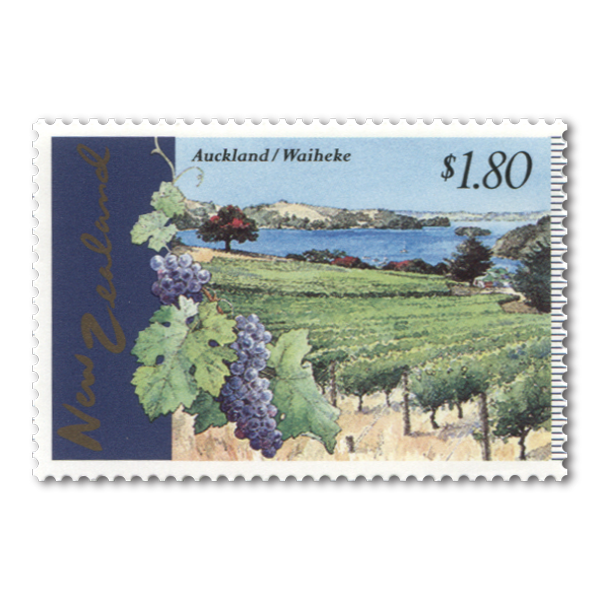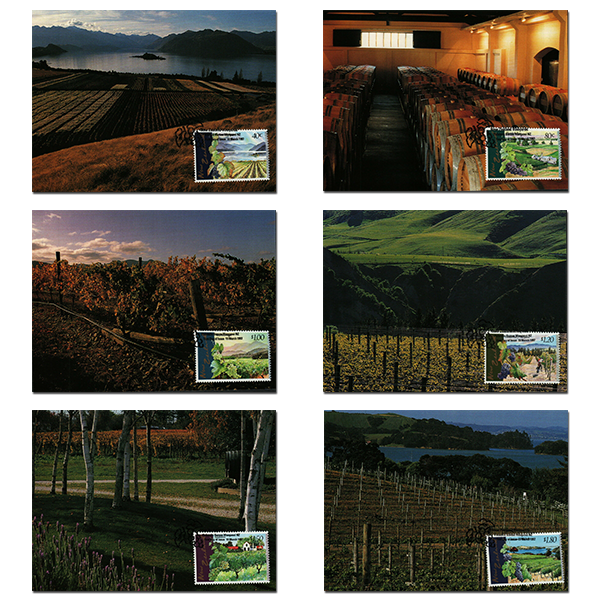New Zealand burst onto the world wine stage in the 1980s with striking Sauvignon Blancs that crammed more flavour into the glass than any other country had ever achieved with that classic French variety. Today's wines are riper and less green-edged in an easier-drinking style, but they are still considered to be some of the best in the world.
Issue information
The grapevine, Shakespeare's "merry cheerer of the heart", found its way to New Zealand soon after the arrival of the first French and English missionaries 150 years ago. However, it was not until the 1980s that the country began to produce wine capable of exciting the palates of wine lovers around the world.
Today, it is well recognised that New Zealand provides ideal grape-growing conditions. The warm sunshine, light rains and long autumn ripening period - along with the increasing skill of our winemakers - help to produce the intensity of flavour, elegance and style for which New Zealand wines have become renowned.
This stamp issue celebrated the geographical diversity and beauty of our vineyards. Each stamp depicted a vineyard from one of the country's main wine-growing regions.
Miniature Sheet Booklet
A colourful booklet with 28 pages, including seven miniature sheets of the vineyards stamps complemented this issue.
The booklet contained a wealth of information about the wine industry in New Zealand and the wine regions featured on the stamps.
Product Listing for New Zealand Vineyards
| Image | Title | Description | Price |
|---|---|---|---|
 |
Single Stamp |
Single 40c 'Central Otago' gummed stamp. This stamp featured the Rippon vineyard, situated on the edge of Lake Wanaka and surrounded by snow-capped peaks of the Southern Alps. The area's extreme dryness reduced the risk of disease and allowed an extended autumn ripening period. Central Otago's first Méthode Champenoise was produced by Rippon in 1993. |
$0.40 |
 |
Single Stamp |
Single 80c 'Hawke's Bay' gummed stamp. Hawke's Bay Chardonnays, oak-matured Sauvignon Blancs and Cabernet-based reds from this region ranked amongst the best in the country. Marist missionaries planted the first vines in 1851 in the Hawke's Bay and by the 1890s several wealthy landowners were producing commercial volumes of wine. The Hawke's Bay climate of warm, sunny summers, dryish autumns and a strong maritime influence has distinct parallels with Bordeaux in France - an area renowned for Cabernet Sauvignon and Merlot-based reds. The whitewashed designer home of wine producer John Buck surrounded by the vines of the Te Mata Estate was recreated on this stamp. Buck established Te Mata Estate in the late 1970s, and the vineyard became famous for its two high-quality reds: Coleraine and Awatea. |
$0.80 |
 |
Single Stamp |
Single $1.00 'Marlborough' gummed stamp. Marlborough is by far New Zealand's largest wine region, with almost 40 percent of all plantings. Grapevines sweep across the pebble, pancake-flat Wairau Valley, and are also well-established in the Awatere Valley, over the hills to the south-east. Sauvignon Blanc is the flagship varietal of Marlborough, and Cloudy Bay, the vineyard featured on this stamp has received much acclaim for its Sauvignon Blancs, as well as its Chardonnays. |
$1.00 |
 |
Single Stamp |
Single $1.20 'Canterbury/Waipara' gummed stamp. The Christchurch district produces leaner, steelier wines than the more robust and ripely flavoured wines flowing from the sheltered warmer sites in North Canterbury, the location of Pegasus Bay which is shown on this stamp. Pegasus Bay, the largest vineyard in the Waipara region, is planted on a bed of smooth stones left by the retreat of an ice-age glacier. The heat retention and reflection of the stones help Pegasus Bay to ripen grape varieties not normally seen this far south. Among these, the Pegasus Bay Cabernet Sauvignon/Merlot is a red wine that has gained a big reputation. |
$1.20 |
 |
Single Stamp |
Single $1.50 'Gisborne' gummed stamp. Gisborne growers produced over a third of the total New Zealand grape harvest in 1997. Sun drenched Gisborne is a wine grower's paradise which particularly favours the Chardonnay grape. The Millton Vineyard is shown on this stamp, a winery that has gained renown for its natural, chemical-free methods of winemaking, as well as the quality of its white wines. One of the Millton success stories is the Millton Opou Riesling. |
$1.50 |
 |
Single Stamp |
Single $1.80 'Auckland/Waiheke' gummed stamp. Only three percent of New Zealand's vines are planted in the Auckland region, but over a quarter of the wine companies are based in Auckland. Thick skinned Cabernet Sauvignon grapes flourish in Auckland's warm and sunny, but relatively damp climate producing sturdy red wines with rich blackcurrant and spice flavours. Kim and Jeanette Goldwater pioneered wine-making on Waiheke Island in the Hauraki gulf. It was fitting that their vineyard, Goldwater Estate, appeared on this stamp. Goldwater wines have won numerous international awards, but their 'star' is the Goldwater Cabernet Sauvignon/Marlot/Franc. |
$1.80 |
 |
Miniature Sheet Booklet | Collectable booklet containing a range of miniature sheets and further information on the stamp issue. | $13.40 |
 |
First Day Cover | First day cover with stamps affixed. Cancelled on the first day of issue. | $7.20 |
 |
Set of Maximum Cards | Pre-paid set of six postcards featuring a stamp on the front and artwork from the stamp issue. | $7.95 |
 |
Limited Edition | Limited edition collectable containing exclusive stamp products not available anywhere else. | $135.00 |
Technical information
New Zealand Vineyards
| Date of issue: | 19 March 1997 |
|---|---|
| Stamps and first day cover illustrated by: | Nancy Tichborne, Akaroa, New Zealand |
| Stamps and first day cover designed by: | Dianne Prosser, Wellington, New Zealand |
| Number of stamps: | Six |
| Denominations and designs: | 40c Central Otago, 80c Hawke's Bay, $1.00 Marlborough, $1.20 Canterbury/Waipara, $1.50 Gisborne, $1.80 Auckland/Waiheke |
| Printer and process: | Southern Colour Print, Dunedin, New Zealand by lithography |
| Number of colours: | Four process colours, plus gold, and plus one special colour each denomination |
| Stamp size and format: | 44.3mm x 30mm (horizontal) |
| Number of stamps per sheet: | 100 |
| Perforation gauge: | 14 |
| Paper type: | 103gsm red phosphor coated gummed stamp paper, unwatewrmarked |
| Cost of unaddressed first day cover: | $7.20 |
| Special blocks: | Plate/imprint, positional or value blocks could be obtained by purchasing at least six stamps. |
| Colour blocks: | Also known as 'traffic lights', these blocks were included in plate blocks. |
| Barcode blocks: | Barcode blocks were available in both A and B formats and could be obtained by purchasing at least two stamps. |
| Period of sale: | These stamps remained on sale until 19 March 1998. |
New Zealand Vineyards Miniature Sheet Booklet
| Date of issue: | 19 March 1997 |
|---|---|
| Miniature sheets and booklet designed by: | Communication Arts Limited, Wellington, New Zealand |
| Miniature sheets printed by: | Southern Colour Print, Dunedin, New Zealand by lithography |
| Miniature sheet size and format: | 160mm x 110mm (horizontal) |
| Number of miniature sheets in booklet: | Seven; One of each stamp denomination and one containing all six stamps |
| Perforation gauge: | 14 |
| Number of colours: | Four process colours, plus gold, and plus one special colour per denomination |
| Paper type: | 103gsm gummed stamp paper |
| Booklet produced by: | Communication Arts Limited, Wellington, New Zealand |
| Booklet contains: | 28 pages including seven miniature sheets |
| Cost of booklet: | $13.40 (face value of the miniature sheets) |
| Period of sale: | Due to limited supply, these booklets remained on sale until stock was exhausted. |

